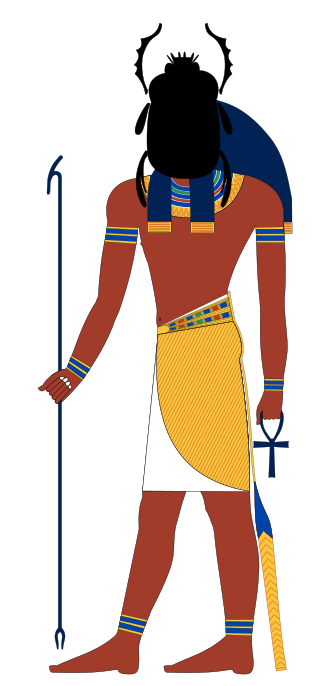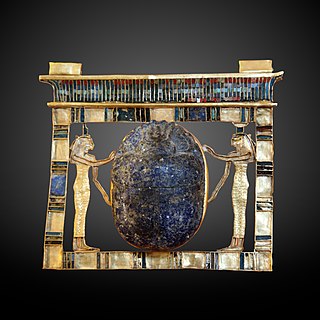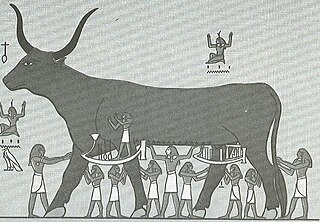
Abydos is one of the oldest cities of ancient Egypt, and also of the eighth nome in Upper Egypt. It is located about 11 kilometres west of the Nile at latitude 26° 10' N, near the modern Egyptian towns of El Araba El Madfuna and El Balyana. In the ancient Egyptian language, the city was called Abedju (Arabic Abdu عبد-و). The English name Abydos comes from the Greek Ἄβυδος, a name borrowed by Greek geographers from the unrelated city of Abydos on the Hellespont. Abydos name in hieroglyphs

Khepri is a scarab-faced god in ancient Egyptian religion who represents the rising or morning sun. By extension, he can also represent creation and the renewal of life.

Menmaatre Seti I was the second pharaoh of the Nineteenth Dynasty of Egypt during the New Kingdom period, ruling c. 1294 or 1290 BC to 1279 BC. He was the son of Ramesses I and Sitre, and the father of Ramesses II.

Horemheb, also spelled Horemhab, Haremheb or Haremhab, was the last pharaoh of the 18th Dynasty of Egypt. He ruled for at least 14 years between 1319 BC and 1292 BC. He had no relation to the preceding royal family other than by marriage to Mutnedjmet, who is thought to have been the daughter of his predecessor, Ay; he is believed to have been of common birth.

Menpehtyre Ramesses I was the founding pharaoh of ancient Egypt's 19th Dynasty. The dates for his short reign are not completely known but the timeline of late 1292–1290 BC is frequently cited as well as 1295–1294 BC. While Ramesses I was the founder of the 19th Dynasty, his brief reign mainly serves to mark the transition between the reign of Horemheb, who had stabilized Egypt in the late 18th Dynasty, and the rule of the powerful pharaohs of his own dynasty, in particular his son Seti I, and grandson Ramesses II.

The New Kingdom, also called the Egyptian Empire, refers to ancient Egypt between the 16th century BC and the 11th century BC. This period of ancient Egyptian history covers the Eighteenth, Nineteenth, and Twentieth dynasties. Through radiocarbon dating, the establishment of the New Kingdom has been placed between 1570 BC and 1544 BC. The New Kingdom followed the Second Intermediate Period and was succeeded by the Third Intermediate Period. It was the most prosperous time for the Egyptian people and marked the peak of Egypt's power.

Seti II was the fifth pharaoh of the Nineteenth Dynasty of Egypt and reigned from c. 1203 BC to 1197 BC. His throne name, Userkheperure Setepenre, means "Powerful are the manifestations of Re, the chosen one of Re." He was the son of Merneptah and Isetnofret II and occupied the throne during a period known for dynastic intrigue and short reigns, and his rule was no different. Seti II had to deal with many serious plots, most significantly the accession of a rival king named Amenmesse, possibly a half brother, who seized control over Thebes and Nubia in Upper Egypt during his second to fourth regnal years.

Merneptah or Merenptah was the fourth pharaoh of the Nineteenth Dynasty of Ancient Egypt. According to contemporary historical records, he ruled Egypt for almost ten years, from late July or early August 1213 until his death on 2 May 1203. He was the first royal-born pharaoh since Tutankhamun of the Eighteenth Dynasty of Egypt.

Sitre or Tia-Sitre, was the Great Royal Wife of Pharaoh Ramesses I of Egypt and mother of Seti I.

The tomb of Seti I, also known by its tomb number, KV17, is the tomb of Pharaoh Seti I of the Nineteenth Dynasty. Located in Egypt's Valley of the Kings, It is also known by the names "Belzoni's tomb", "the Tomb of Apis", and "the Tomb of Psammis, son of Nechois". It is one of the most decorated tombs in the valley, and is one of the largest and deepest tombs in the Valley of the Kings. It was uncovered by Italian archaeologist and explorer Giovanni Battista Belzoni on 16 October 1817.

Amenmesse was the fifth pharaoh of the Nineteenth Dynasty in Ancient Egypt, possibly the son of Merneptah and Queen Takhat. Others consider him to be one of the innumerable sons of Ramesses II. Very little is known about this pharaoh, who ruled Egypt for only three to four years. Various Egyptologists date his reign between 1202 BC–1199 BC or 1203 BC–1200 BC with others giving an accession date of 1200 BC. Amenmesse means "born of or fashioned by Amun" in Egyptian. Additionally, his nomen can be found with the epithet Heqa-waset, which means "Ruler of Thebes". His royal name was Menmire Setepenre.
The Book of Gates is an ancient Egyptian funerary text dating from the New Kingdom. The Book of Gates is long and detailed, consisting of one hundred scenes. It narrates the passage of a newly deceased soul into the next world journeying with the sun god, Ra, through the underworld during the hours of the night towards his resurrection. The soul is required to pass through a series of 'gates' at each hour of the journey. Each gate is guarded by a different serpent deity that is associated with a different goddess. It is important that the deceased knows the names of each guardian. Depictions of the judgment of the dead are shown in the last three hours. The text implies that some people will pass through unharmed, but others will suffer torment in a lake of fire. At the end of Ra's journey through the underworld, he emerges anew to take his place back in the sky.

Akhenre Setepenre Siptah or Merneptah Siptah was the penultimate ruler of the Nineteenth Dynasty of Egypt. His father's identity is currently unknown. Both Seti II and Amenmesse have been suggested although the fact that Siptah later changed his royal name or nomen to Merneptah Siptah after his Year 2 suggests rather that his father was Merneptah. If correct, this would make Siptah and Seti II half-brothers since both of them were sons of Merneptah.

Tomb KV15, located in the Valley of the Kings in Egypt, was used for the burial of Pharaoh Seti II of the Nineteenth Dynasty. The tomb was dug into the base of a near-vertical cliff face at the head of a wadi running southwest from the main part of the Valley of the Kings. It runs along a northwest-to-southeast axis, comprising a short entry corridor followed by three corridor segments, which terminate in a well room that lacks a well, which was never dug. This then connects with a four-pillared hall and another stretch of corridor that was converted into a burial chamber.

Takhat was an ancient Egyptian princess and queen of the 19th Dynasty, the mother of the usurper pharaoh Amenmesse.

Paser was an ancient Egyptian noble who served as vizier during the reigns of Seti I and Ramesses II in the 19th Dynasty. He would later also become High Priest of Amun.
Dorothy Louise Eady, also known as Omm Sety or Om Seti, was a British antiques caretaker and folklorist. She was keeper of the Abydos Temple of Seti I and draughtswoman for the Department of Egyptian Antiquities. She is known for her belief that in a previous life she had been a priestess in ancient Egypt, as well as her considerable historical research at Abydos. Her life and work has been the subject of many articles, television documentaries, and biographies.

Ramesses II, commonly known as Ramesses the Great, was an Egyptian pharaoh. He was the third ruler of the Nineteenth Dynasty. Along with Thutmose III of the Eighteenth Dynasty, he is often regarded as the greatest, most celebrated, and most powerful pharaoh of the New Kingdom, which itself was the most powerful period of ancient Egypt. He is also widely considered one of ancient Egypt's most successful warrior pharaohs, conducting no fewer than 15 military campaigns, all resulting in victories, excluding the Battle of Kadesh, generally considered a stalemate.

The Book of the Heavenly Cow, or the Book of the Cow of Heaven, is an Ancient Egyptian text thought to have originated during the Amarna Period and, in part, describes the reasons for the imperfect state of the world in terms of humankind's rebellion against the supreme sun god, Ra. Divine punishment was inflicted through the goddess Hathor, with the survivors suffering through separation from Ra, who now resided in the sky on the back of Nut, the heavenly cow.

The gate deities of the underworld were ancient Egyptian minor deities charged with guarding the gates of the Egyptian underworld.


















